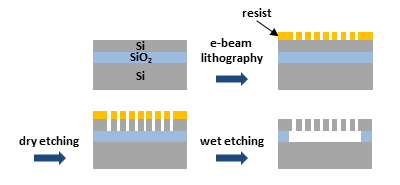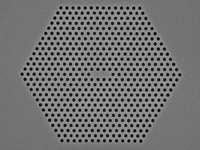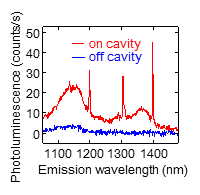Research:Enhancement of carbon nanotube photoluminescence by photonic crystals
Photonic crystals are structures that have periodic changes in their refractive index. Similar to the way a periodic potential in a crystal opens up a bandgap in electronic energy, photonic bandgap can form within photonic crystals. Since a photon whose energy within the gap cannot propagate in the photonic crystal, it is possible to confine photons by forming a defect in photonic crystals. In other words, defects in photonic crystals act as optical cavities.
Photonic crystal cavities allow tuning of resonant wavelength by changing the structure of the defect, and they have very small mode volumes and quality factors. It is well known that placing a light emitter in a cavity enhances its light emission, and photonic crystal cavities are ideal for coupling to nanomaterials. Here, we demonstrate enhancement of carbon nanotube photoluminescence by photonic crystal cavities.

Photonic crystal nanocavities are fabricated from silicon-on-insulator (SOI) substrates. Periodic changes in refractive index is introduced by eching holes in the top layer. The buried oxide layer is a sacrificial layer for suspending the photonic crystal in air. First, we perform electron beam lithography to pattern the photonic crystal, and dry etching is used to form the array of holes. Next, a wet etching process removes the buried oxide layer.


We deposit nanotube solution on such photonic crystal cavities and perform photoluminescence measurements. As shown in the figure, we observe sharp peaks when the excitation laser is on the cavity, demonstrating enhancement of photoluminescence. Although there are barely any detectable emission off the cavity, we estimate that the photoluminescence is enhanced by a factor of at least 50.
To learn more about this work, please refer to:
Enhancement of carbon nanotube photoluminescence by photonic crystal nanocavities
Appl. Phys. Lett.
101, 141124 (2012).
![]()